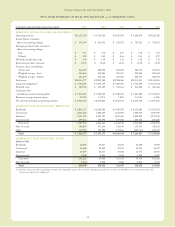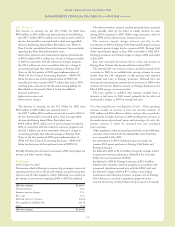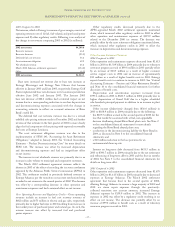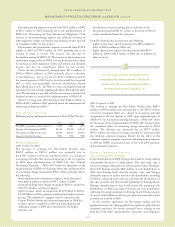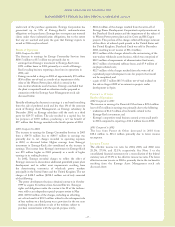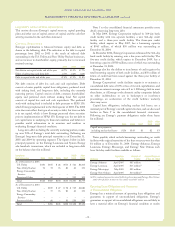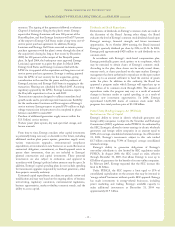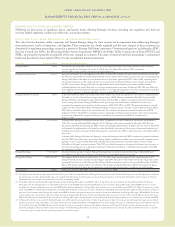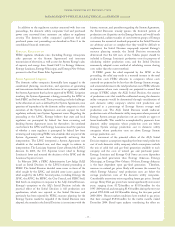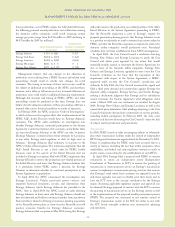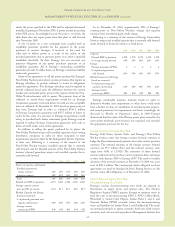Entergy 2004 Annual Report Download - page 33
Download and view the complete annual report
Please find page 33 of the 2004 Entergy annual report below. You can navigate through the pages in the report by either clicking on the pages listed below, or by using the keyword search tool below to find specific information within the annual report.
Entergy Corporation and Subsidiaries 2004
SOURCES OF CAPITAL
Entergy’s sources to meet its capital requirements and to fund
potential investments include:
•internally generated funds;
•cash on hand ($808 million as of December 31, 2004);
•securities issuances;
•bank financing under new or existing facilities; and
•sales of assets.
The majority of Entergy’s internally generated funds come from
the U.S. Utility. Circumstances such as weather patterns, price
fluctuations, and unanticipated expenses, including unscheduled
plant outages and storms, could affect the level of internally
generated funds in the future. In the following section, Entergy’s
cash flow activity for the previous three years is discussed.
Provisions within the Articles of Incorporation or pertinent
indentures and various other agreements relating to the long-term
debt and preferred stock of certain of Entergy Corporation’s
subsidiaries restrict the payment of cash dividends or other
distributions ontheir commonand preferred stock. As of
December 31, 2004, EntergyArkansas and Entergy Mississippi
had restricted retained earnings unavailable for distribution to
EntergyCorporationof $394.9 millionand $68.5 million, respec-
tively. Additionally, PUHCA prohibits Entergy Corporation’s sub-
sidiaries from making loans or advances to Entergy Corporation.
Alldebt and commonand preferred stockissuances by the domes-
tic utilitycompanies and System Energy require prior regulatory
approval and their preferred stock and debt issuances are also sub-
ject to issuance tests set forth in corporate charters, bond inden-
tures, and other agreements. The domestic utility companies and
System Energy have sufficient capacity under these tests to meet
foreseeable capital needs.
The short-term borrowings of Entergy’s subsidiaries are limited
to amounts authorized by the SEC. The current limits authorized
are effective through November 30, 2007. In addition to borrowing
from commercial banks, Entergy’s subsidiaries are authorized under
the SEC order to borrow from Entergy’s money pool. The money
pool is an inter-company borrowing arrangement designed to
reduce Entergy’s subsidiaries’ dependence on external short-term
borrowings. Borrowings from the money pool and external
borrowings combined may not exceed the SEC authorized limits.
As of December 31, 2004, Entergy’s subsidiaries’ aggregate
authorized limit was $1.6 billion and the aggregate outstanding
borrowing from the money pool was $151.6 million. There were no
borrowings outstanding from external sources. Under the SEC
order and without further SEC authorization, the domestic utility
companies and System Energy cannot issue new short-term
indebtedness unless (a) Entergy Corporation and the issuer each
maintain common equity of at least 30% of its capital and (b) with
the exception of money pool borrowings, the debt security to be
issued (if rated) and all outstanding securities of the issuer and
EntergyCorporationthat arerated must be rated investment grade.
See Note 4 to the consolidated financial statements for further
discussionof Entergy’s short-term borrowing limits.
The short- and long-term securities issuances of Entergy
Corporation also are limited to amounts authorized by the
SEC. Under its current SEC order, and without further SEC
authorization, Entergy Corporation cannot incur additional
indebtedness or issue other securities unless (a) Entergy
Corporation and each of its public utility subsidiaries maintain
common equity ratios of at least 30% and (b) the security to
be issued (if rated) and all outstanding securities of Entergy
Corporation that are rated, are rated investment grade.
The long-term securities issuances of Entergy Gulf States,
Entergy Louisiana, Entergy Mississippi, and System Energy also
are limited to amounts authorized by the SEC. Under the current
SEC orders of Entergy Gulf States, Entergy Louisiana, and
EntergyMississippi, and without further SEC authorization, the
issuer cannot incur additional indebtedness or issue other securities
unless (a) it and Entergy Corporation maintain a common equity
ratio of at least 30% and (b) the security to be issued (if rated) and
all outstanding securities of the issuer (other than preferred stock of
Entergy Gulf States), as well as all outstanding securities of Entergy
Corporation, that are rated, arerated investment grade.
Cash Flow Activity
As shown in Entergy’s Statements of Cash Flows, cash flows for the
years ended December 31, 2004, 2003, and 2002 were as follows
(in millions):
2004 2003 2002
Cash and cash equivalents
at beginning of period $ 692 $ 1,335 $ 752
Cash flow provided by (used in):
Operating activities 2,929 2,006 2,181
Investing activities (1,140) (1,783) (1,388)
Financing activities (1,672) (869) (213)
Effect of exchange rates on
cash and cash equivalents (1) 3 3
Net increase (decrease) in
cash and cash equivalents 116 (643) 583
Cash and cash equivalents
at end of period $ 808 $ 692 $ 1,335
Operating Cash Flow Activity
2004 Compared to 2003
Entergy’s cash flow provided by operating activities increased in
2004 primarily due to the following:
•The U.S. Utility provided $2,208 million in cash from operating
activities compared to providing $1,675 million in 2003. The
increase resulted primarily from the receipt of intercompany
income tax refunds from the parent company, Entergy
Corporation. Income tax refunds/payments contributed
approximately $400 million of the increase in cash from
operating activities in 2004. Improved recovery of fuel costs and
areduction in interest paid also contributed to the
increase in 2004.
-31 -
MANAGEMENT’S FINANCIAL DISCUSSION and ANALYSIS continued



